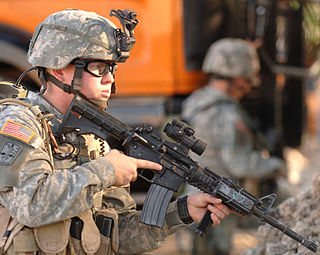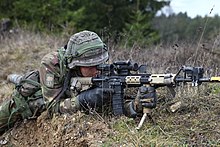
The M4 carbine is a 5.56×45mm NATO assault rifle developed in the United States during the 1980s. It is a shortened version of the M16A2 assault rifle.
The Colt Canada C7 and C8 are a Canadian family of service rifles, manufactured by Colt Canada, having similar design and function to the Colt M16A3.

The Advanced Combat Optical Gunsight (ACOG) is a series of prismatic telescopic sights manufactured by Trijicon. The ACOG was originally designed to be used on the M16 rifle and M4 carbine, but Trijicon has also developed ACOG accessories for other firearms. Models provide fixed-power magnification levels from 1.25× to 6×. ACOG reticles are illuminated at night by an internal tritium phosphor. Some versions have an additional daytime reticle illumination via a passive external fiberoptic light pipe or are LED-illuminated using a dry battery. The first ACOG model, known as the TA01, was released in 1987.

The Heckler & KochXM8 is a lightweight assault rifle system developed from the late 1990s to early 2000s. The rifle was designed by German small arms manufacturer Heckler & Koch (H&K), and shares design and engineering with their G36 rifle.

The 1913 rail, also known as the Picatinny rail is an American rail integration system designed by Richard Swan that provides a mounting platform for firearm accessories. It forms part of the NATO standard STANAG 2324 rail. It was originally used for mounting of scopes atop the receivers of larger caliber rifles.
The Ak 5 is a license-built Swedish version of the Belgian FN FNC assault rifle, with certain modifications, mostly to adapt the weapon to the partially subarctic Swedish climate. The Ak 5 is the current service rifle of the Swedish Armed Forces, adopted in 1986, partially replacing the Ak 4, a license-built version of the Heckler & Koch G3.

The CompM2 is a battery-powered, non-magnifying red dot type of reflex sight for firearms manufactured by Aimpoint AB. It was first introduced in the U.S. Armed Forces in 2000, designated as the M68 Close Combat Optic. It is also known as the M68 Aimpoint and is designed to meet United States military standards. The sight is designed for use with the M16/M4 family of rifles, but can be mounted on any weapon fitted with an upper Picatinny rail. It is also NVG-compatible—the aiming dot is still visible through night vision scopes and goggles. The Army's M68 designation was also applied to a later version of the sight, the Aimpoint CompM4.
The FNSCAR is a family of gas-operated short-stroke gas piston automatic rifles developed by Belgian manufacturer FN Herstal (FN) in 2004. It is constructed with modularity for the United States Special Operations Command (SOCOM) to satisfy the requirements of the SCAR competition. This family of rifles consists of two main types. The SCAR-L, for "light", is chambered in 5.56×45mm NATO and the SCAR-H, for "heavy", is chambered in 7.62×51mm NATO. Both types are available in Close Quarters Combat (CQC), Standard (STD), and Long Barrel (LB) variants.

A designated marksman rifle (DMR) is a modern scoped high-precision rifle used by infantry in the designated marksman (DM) role. It generally fills the engagement range gap between a service rifle and a dedicated sniper rifle, at around 300–600 metres (330–660 yd).
Aimpoint AB is a Swedish optics company based in Malmö, Sweden that manufactures red dot sights.

The Heckler & Koch HK416 is an assault rifle chambered for the 5.56×45mm NATO cartridge. It is designed and manufactured by the German company Heckler & Koch.

The two most common assault rifles in the world are the Soviet AK-47 and the American M16. These Cold War-era rifles have been used in conflicts both large and small since the 1960s. They are used by military, police, security forces, revolutionaries, terrorists, criminals, and civilians alike and will most likely continue to be used for decades to come. As a result, they have been the subject of countless comparisons and endless debate.
The Special Operations Peculiar MODification (SOPMOD) kit is an accessory system for the M4A1 carbine, CQBR, FN SCAR Mk 16/17, HK416 and other weapons used by United States Special Operations Command (USSOCOM) special forces units, though it is not specific to SOCOM. The kit allows US Special Operations Forces personnel to configure their weapons to individual preferences and customize for different mission requirements.

The Special Actions Detachment or DAE is the tier one special force maritime unit of the Portuguese Navy. It is part of the Portuguese Marine Corps. Raised in 1985, the DAE is one of the smallest special forces units within the Portuguese Armed Forces. It is responsible for conducting air-sea rescue, amphibious reconnaissance, amphibious warfare, black operation, bomb disposal, CBRN defense, coastal raiding, counterterrorism, direct action, executive protection, hostage rescue, irregular warfare, ISTAR, long-range penetration, JTAC, manhunt high-value target, maritime sabotage, mountain rescue, naval boarding, operation behind high risk enemy lines, special operations, special reconnaissance, tracking targets, underwater demolition, unconventional warfare, other missions in support of Portuguese and NATO armed forces. DAE's mission and training are similar to their American counterparts DEVGRU and the British SBS. DAE often trains with them alongside other SMU counter-terror units.

The M6 is a series of carbines designed and manufactured by LWRC International. It is based on the M4 carbine, with which it shares 80% of its parts. The 'M' model name is not a US military designation. Like the HK416, it features a proprietary short-stroke self-regulating gas piston system and bolt carrier/carrier key design, which prevents trapped gases from contacting the bolt carrier or receiver of the weapon. The manufacturer claims that this reduces the heating and carbon fouling of the internals, simplifies field maintenance, and improves reliability.

The C79 optical sight (SpecterOS3.4x) is a telescopic sight manufactured by Elcan. A variant, the M145 Machine Gun Optic is in use by the US military. It is 3.4×28, meaning 3.4x magnification, and a 28mm diameter objective lens. A tritium illuminated reticle provides for normal and low-light conditions sighting. It can be mounted to a variety of rifles and light machine guns using the Picatinny rail mounting system or the similar Diemaco rail system found on small arms produced by Diemaco/Colt Canada. Similar rifle sights are the Sight Unit Small Arms, Trilux (SUSAT) and the Advanced Combat Optical Gunsight (ACOG).

A red dot sight is a common classification for a non-magnifying reflector sight that provides an illuminated red dot to the user as a point of aim. A standard design uses a red light-emitting diode (LED) at the focus of collimating optics, which generates a dot-style illuminated reticle that stays in alignment with the firearm the sight is attached to, regardless of eye position.

The Individual Carbine was a competition to select the planned successor to the M4 carbine in the United States Army.

A holographic weapon sight or holographic diffraction sight is a non-magnifying gunsight that allows the user to look through a glass optical window and see a holographic reticle image superimposed at a distance on the field of view. The hologram of the reticle is built into the window and is illuminated by a laser diode.

Scope mounts are rigid implements used to attach (typically) a telescopic sight or other types of optical sights onto a firearm. The mount can be made integral to the scope body or, more commonly, an external fitting that clamp onto the scope tube via screw-tightened rings. The scope and mount are then fastened onto compatible interfaces on the weapon. Words such as mounts and bases are used somewhat loosely, and can refer to several different parts which are either used together or in place of each other as ways to mount optical sights to firearms.
















